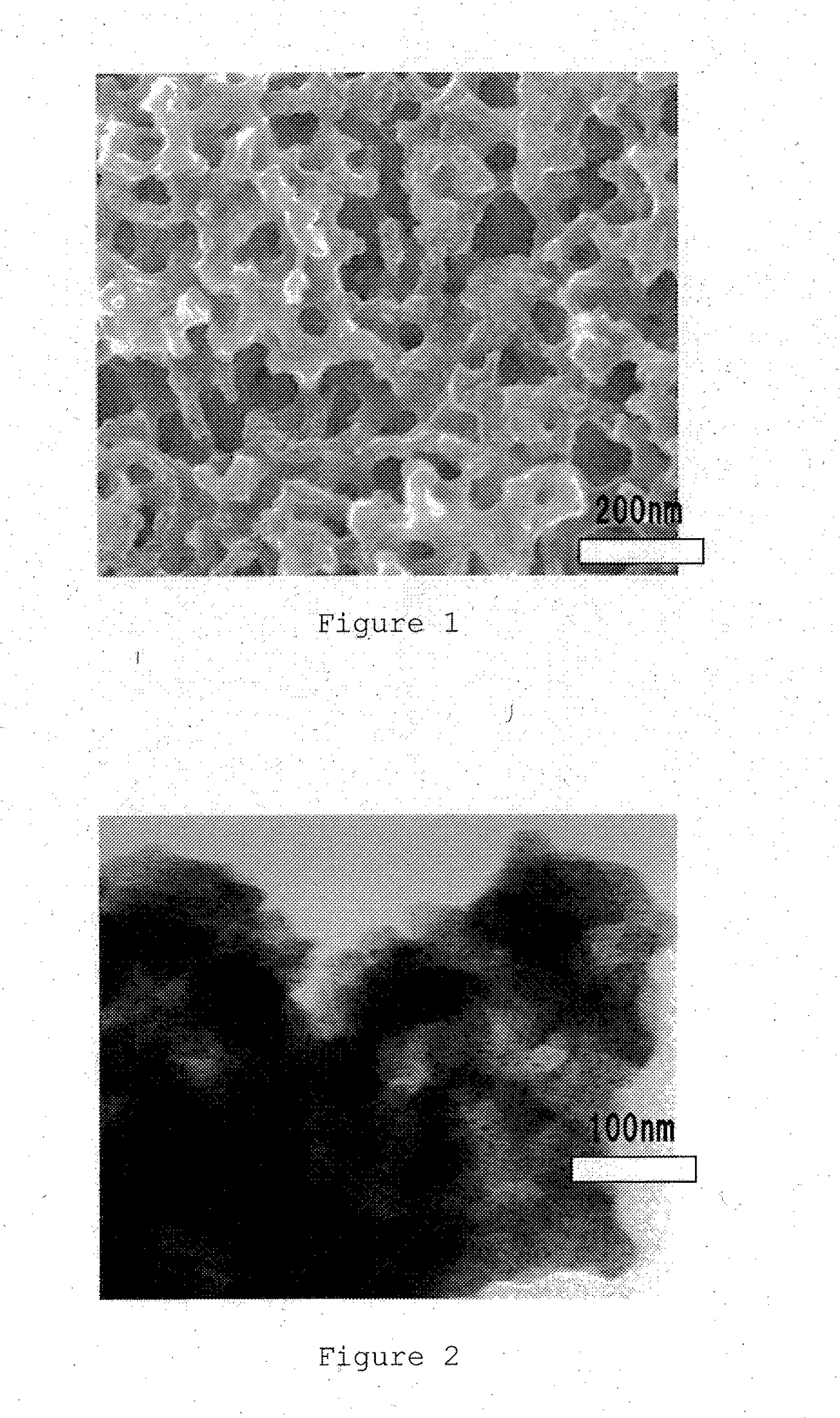Metal composite carbon material, fuel cell catalyst, fuel cell, hydrogen-occluding material, hydrogen tank, and production method for metal composite carbon material
a technology of metal composite carbon and fuel cell, which is applied in the direction of metal/metal-oxide/metal-hydroxide catalyst, cell components, physical/chemical process catalysts, etc., can solve the problems of limited contact between fixed metal fine particles and metal oxide fine particles with fluid, and the presence of continuous pores, etc., to achieve the effect of reducing the flow resistance of fluid, reducing the degree of deformation resistance, and increasing the electrical conductivity and thermal conductivity
- Summary
- Abstract
- Description
- Claims
- Application Information
AI Technical Summary
Benefits of technology
Problems solved by technology
Method used
Image
Examples
example 1
[0166]Into a separable flask were introduced 70 g of polyacrylonitrile (Mw, 150,000) manufactured by Polysciences, Inc., as a carbonizable resin, 70 g of polyvinylpyrrolidone (Mw, 40,000) manufactured by Sigma Aldrich, as an eliminable resin, and 400 g of dimethyl sulfoxide (DMSO) manufactured by WAKENYAKU CO. LTD., as a solvent. The contents were heated at 150° C. for 3 hours with stirring and refluxing, thereby preparing a resin mixture of an even and transparent solution. In this solution, the concentration of the polyacrylonitrile and the concentration of the polyvinylpyrrolidone were 13% by weight each.
[0167]The resin mixture obtained was cooled to 25° C. and then ejected at a rate of 3 mL / min from a one-orifice nozzle having an orifice diameter of 0.6 mm, and the extrudate was led into a pure-water coagulating bath kept at 25° C., subsequently taken off at a rate of 6 m / min, and accumulated in a vat to thereby obtain raw fibers with a microstructure. In this operation, the air...
example 2
[0178]Potassium hydroxide in an amount 4 times as much as the carbonized material was mixed with the carbon powder in Example 1, the mixture was then introduced into a rotary kiln, and the temperature was increased to 820° C. under a flow of nitrogen. The mixture was subjected to an activation treatment for 1 hour and 45 minutes, and the temperature was thereafter decreased. Using water and dilute hydrochloric acid, the resulting mixture was washed until the pH became about 7. The carbon powder obtained after the treatment had an average porosity in the co-continuous structural portion of 63% and a structural period of 76 nm. Further, the carbon powder had a structure which contained a portion having no co-continuous structure in a portion of the particles. The BET specific surface area was 2590 m2 / g, the average diameter of the pore by the MP method was 0.8 nm, and the pore volume was 2.2 cm2 / g.
[0179]Thereafter, using the carbon powders obtained, the metal fine particles were suppo...
PUM
| Property | Measurement | Unit |
|---|---|---|
| porosity | aaaaa | aaaaa |
| diameter | aaaaa | aaaaa |
| size | aaaaa | aaaaa |
Abstract
Description
Claims
Application Information
 Login to View More
Login to View More - R&D
- Intellectual Property
- Life Sciences
- Materials
- Tech Scout
- Unparalleled Data Quality
- Higher Quality Content
- 60% Fewer Hallucinations
Browse by: Latest US Patents, China's latest patents, Technical Efficacy Thesaurus, Application Domain, Technology Topic, Popular Technical Reports.
© 2025 PatSnap. All rights reserved.Legal|Privacy policy|Modern Slavery Act Transparency Statement|Sitemap|About US| Contact US: help@patsnap.com



